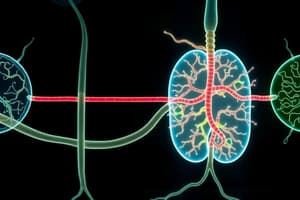Podcast
Questions and Answers
What is the removal of electrons called?
What is the removal of electrons called?
- Oxidation (correct)
- Phosphorylation
- Substrate-level phosphorylation
- Reduction
What is the gain of electrons called?
What is the gain of electrons called?
- Decarboxylation
- Dehydrogenation
- Oxidation
- Reduction (correct)
In biological systems, the removal of electrons and protons at the same time is equivalent to the removal of what?
In biological systems, the removal of electrons and protons at the same time is equivalent to the removal of what?
- Hydrogen atom (correct)
- Oxygen atom
- Nitrogen atom
- Carbon atom
What is the initial step in carbohydrate catabolism?
What is the initial step in carbohydrate catabolism?
What is the final electron acceptor in cellular respiration?
What is the final electron acceptor in cellular respiration?
In the electron transport chain, what does each NADH molecule produce?
In the electron transport chain, what does each NADH molecule produce?
What is NOT the final electron acceptor in anaerobic respiration?
What is NOT the final electron acceptor in anaerobic respiration?
Which process yields less energy?
Which process yields less energy?
Which of the following is NOT a characteristic of fermentation?
Which of the following is NOT a characteristic of fermentation?
What is the main product of homolactic fermentation?
What is the main product of homolactic fermentation?
What are the products of alcohol fermentation?
What are the products of alcohol fermentation?
Which of the following microorganisms is used in Swiss cheese production?
Which of the following microorganisms is used in Swiss cheese production?
What is the starting material for acetone and butanol fermentation?
What is the starting material for acetone and butanol fermentation?
Which of the following end-products is used as a fuel?
Which of the following end-products is used as a fuel?
What do bacteria that catabolize carbohydrate or protein produce?
What do bacteria that catabolize carbohydrate or protein produce?
What enzyme do bacteria identified by the oxidase test possess?
What enzyme do bacteria identified by the oxidase test possess?
Which microorganism is used to produce beer and wine?
Which microorganism is used to produce beer and wine?
What is the primary starting material for producing ethanol for fuel using Saccharomyces cerevisiae?
What is the primary starting material for producing ethanol for fuel using Saccharomyces cerevisiae?
Which of the following is produced through fermentation using Acetobacter?
Which of the following is produced through fermentation using Acetobacter?
What starting material is used in the production of cheese and yogurt?
What starting material is used in the production of cheese and yogurt?
Which microorganism is involved in the production of rye bread?
Which microorganism is involved in the production of rye bread?
What is the main starting material for making sauerkraut?
What is the main starting material for making sauerkraut?
Which bacteria is used in the fermentation process of summer sausage?
Which bacteria is used in the fermentation process of summer sausage?
Which of the following is NOT a fermentation end-product listed?
Which of the following is NOT a fermentation end-product listed?
What is the industrial use of ethanol produced by Saccharomyces cerevisiae from starch or sugar?
What is the industrial use of ethanol produced by Saccharomyces cerevisiae from starch or sugar?
Which two microorganisms are used in the production of cheese and yogurt?
Which two microorganisms are used in the production of cheese and yogurt?
Flashcards
Oxidation
Oxidation
Removal of electrons from a molecule.
Reduction
Reduction
Gain of electrons by a molecule.
Redox reaction
Redox reaction
A chemical reaction involving both oxidation and reduction.
Glycolysis
Glycolysis
Signup and view all the flashcards
Krebs cycle
Krebs cycle
Signup and view all the flashcards
ATP Production from NADH
ATP Production from NADH
Signup and view all the flashcards
ATP Production from FADH2
ATP Production from FADH2
Signup and view all the flashcards
Anaerobic Respiration
Anaerobic Respiration
Signup and view all the flashcards
Fermentation Definition
Fermentation Definition
Signup and view all the flashcards
Lactic Acid Fermentation
Lactic Acid Fermentation
Signup and view all the flashcards
Alcohol Fermentation
Alcohol Fermentation
Signup and view all the flashcards
Final Electron Acceptor
Final Electron Acceptor
Signup and view all the flashcards
Fermentation Test
Fermentation Test
Signup and view all the flashcards
Oxidase Test
Oxidase Test
Signup and view all the flashcards
Propionic Acid
Propionic Acid
Signup and view all the flashcards
Citric Acid
Citric Acid
Signup and view all the flashcards
Methane Production
Methane Production
Signup and view all the flashcards
Ethanol
Ethanol
Signup and view all the flashcards
Saccharomyces cerevisiae
Saccharomyces cerevisiae
Signup and view all the flashcards
Acetic Acid
Acetic Acid
Signup and view all the flashcards
Acetobacter
Acetobacter
Signup and view all the flashcards
Lactic Acid
Lactic Acid
Signup and view all the flashcards
Lactobacillus
Lactobacillus
Signup and view all the flashcards
Streptococcus
Streptococcus
Signup and view all the flashcards
Lactobacillus delbrueckii
Lactobacillus delbrueckii
Signup and view all the flashcards
Lactobacillus plantarum
Lactobacillus plantarum
Signup and view all the flashcards
Pediococcus
Pediococcus
Signup and view all the flashcards
Study Notes
Microbial Metabolism
- Microbial metabolism involves a series of enzymatically catalyzed chemical reactions.
- These reactions extract energy from organic compounds and store it in chemical form (ATP).
Oxidation-Reduction Reactions
- Oxidation: Removal of electrons.
- Reduction: Gain of electrons.
- Redox reaction: An oxidation reaction paired with a reduction reaction.
- In biological systems, electrons and protons are removed simultaneously, equivalent to a hydrogen atom.
- Biological oxidations are often dehydrogenations.
Carbohydrate Catabolism
- Breakdown of carbohydrates to release energy.
- Glycolysis
- Krebs cycle
- Electron transport chain (system)
Glycolysis
- Oxidation of glucose to pyruvic acid produces ATP and NADH.
Cellular Respiration
- Oxidation of molecules liberates electrons to operate an electron transport chain.
- The final electron acceptor is inorganic and from outside the cell.
- ATP is generated by oxidative phosphorylation.
Aerobic Respiration
- Krebs cycle:
- Pyruvic acid (from glycolysis) is oxidized and decarboxylation (loss of CO2) occurs.
- The resulting two-carbon compound attaches to coenzyme A, forming acetyl CoA and NADH.
- Oxidation of acetyl CoA produces NADH, FADH2, and ATP, and liberates CO2 as waste.
Carbohydrate Catabolism (Continued)
- Each NADH can be oxidized in the electron transport chain to produce 3 molecules of ATP.
- Each FADH2 can produce 2 molecules of ATP.
Anaerobic Respiration
- The final electron acceptor in the electron transport chain is not O2.
- Yields less energy than aerobic respiration.
- Electron Acceptor: NO3-, SO42-, CO32-
- Products: NO2, N2 + H2O; H2S + H2O; CH4 + H2O, respectively.
ATP Yield During Prokaryotic Aerobic Respiration
- Glycolysis: 2 ATP (substrate-level phosphorylation), 6 ATP (oxidative phosphorylation).
- Preparatory Step: 6 ATP (oxidative phosphorylation).
- Krebs Cycle: 2 GTP (equivalent of ATP; substrate-level phosphorylation), 18 ATP (oxidative phosphorylation), 4 ATP (oxidative phosphorylation).
- Total: 38 ATP
Fermentation
- Releases energy from the oxidation of organic molecules.
- Does not require oxygen.
- Does not use the Krebs cycle or ETC.
- Uses an organic molecule as the final electron acceptor.
- Produces only small amounts of ATP.
Types of Fermentation
- Lactic acid fermentation: Produces lactic acid.
- Homolactic: Produces lactic acid only.
- Heterolactic: Produces lactic acid and other compounds.
- Alcohol fermentation: Produces ethanol + CO2. Glucose is oxidized to pyruvic acid; pyruvic acid is converted to acetaldehyde and CO2; NADH reduces acetaldehyde to ethanol.
Lipid and Protein Catabolism
- Protein: Extracellular proteases → Amino acids → Deamination, decarboxylation, dehydrogenation, desulfurization → Organic acid → Krebs cycle.
- Lipid: Lipids (fats) → Lipase → Glycerol → Dihydroxyacetone phosphate, Glyceraldehyde 3-phosphate → Glycolysis → Pyruvic acid → Acetyl CoA → Krebs cycle.
Photosynthesis
- Light-dependent (light) reactions: Conversion of light energy into chemical energy (ATP and NADPH).
- Light-independent (dark) reactions: ATP and NADPH are used to reduce CO2 to sugar (carbon fixation) via the Calvin-Benson cycle.
Types of Photosynthesis
- Oxygenic: 6 CO2 + 12 H2O + Light energy → C6H12O6 + 6 H2O + 6 O2
- Anoxygenic: 6 CO2 + 12 H2S + Light energy → C6H12O6 + 6 H2O + 12 S
Photophosphorylation
- Two types: cyclic, non-cyclic.
Metabolic Diversity Among Organisms
- Phototrophs use light energy.
- Chlorophyll is oxidized.
- Photoautotrophs: Use energy in the Calvin-Benson cycle to fix CO2 to sugar.
- Oxygenic: Produces O2.
- Anoxygenic: Does not produce O2.
- Chemoautotrophs: Use inorganic compounds for energy.
- Chemoheterotrophs: Use organic compounds.
Biochemical Tests and Bacterial Identification
- Fermentation test: Detects bacteria capable of carbohydrate or protein catabolism, indicated by pH indicator color change.
- Oxidase test: Identifies bacteria with cytochrome oxidase using specific color reagent.
Studying That Suits You
Use AI to generate personalized quizzes and flashcards to suit your learning preferences.
Related Documents
Description
Test your knowledge on cellular respiration and fermentation processes in biochemistry. This quiz includes questions on electron transport chains, fermentation types, and the role of specific microorganisms. Perfect for students studying cellular metabolism.



